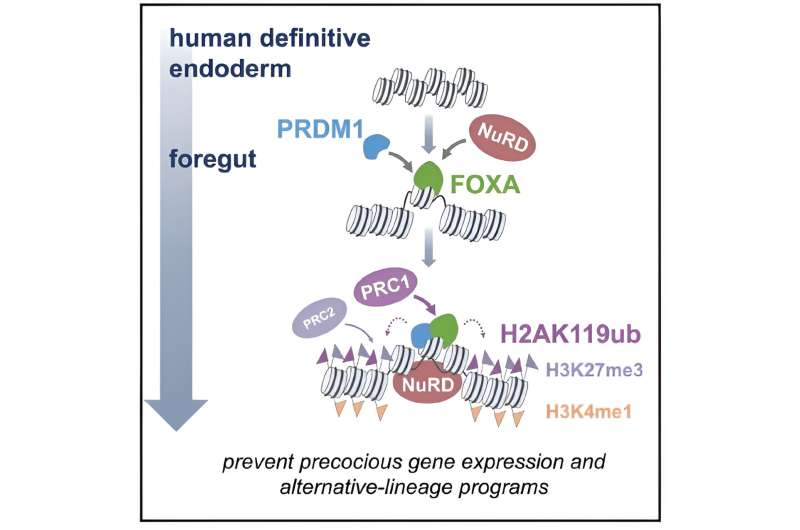This article has been reviewed according to Science X's editorial process and policies. Editors have highlighted the following attributes while ensuring the content's credibility:
fact-checked
peer-reviewed publication
trusted source
proofread
How pioneer transcription factors blaze the one trail that determines cell fate

One of the important breakthroughs that made it possible to program or reprogram cell fate more efficiently and with higher fidelity in a dish was discovering how to make use of a small set of molecular cowboys called pioneer transcription factors (TFs).
Every cell in our bodies has more than 200 transcription factors expressed inside, riding along the DNA helix and instructing specific genes to activate and deactivate. During the early stages of fetal development, a small subset of "pioneer" TFs act inside our precursor cells, There driving them to make the mature cells that become parts of the spine, the heart, the liver, and so on.
Identifying the key pluripotent pioneer TFs helped researchers learn how to make induced pluripotent stem cells from any type of adult cells, which could then be instructed to make other types of cells, thus forming organoids that can mimic functional organ tissue. Furthermore, tissue-specific pioneer TFs can directly reprogram one adult cell type into a targeted cell type without passing through a pluripotent state.
Currently, there is considerable interest in producing therapeutic target cells from pioneer TF-mediated reprogramming of skin or other accessible somatic cells, as they hold great promise for personalized disease modeling and regenerative medicine. However, a major challenge is achieving sufficient gene repression of the original cell type, as inadequate repression often leads to the formation of "dead-end" cells or hybrid cells, thus limiting translational applications.
Now a study published in Molecular Cell, reveals important new details about how pioneer TFs do their important jobs.
"As we gain a more comprehensive understanding of the mechanisms underlying pioneer TF-mediated gene repression, it will greatly enhance the precise manipulation of cell fate in cellular programming and reprogramming," says Makiko Iwafuchi, Ph.D., a member of the Division of Developmental Biology and the Center for Stem Cell & Organoid Medicine at Cincinnati Children's.
The first author, Satoshi Matsui, Ph., and Iwafuchi collaborated with Hee-Woong Lim, Ph., a co-senior author and a member of the Division of Biomedical Informatics, on the study.
Until this study, most experts believed that pioneer TFs functioned primarily by activating genes to send cells toward their ultimate fates. However, scientists have learned that our genetic programming is packed with alternative pathways, which must be actively shut down.
So, how does the body ensure that precursor cells consistently follow the correct path? It turns out that pioneer TFs do more than push cells in the desired direction. When functioning correctly, these cowboys ride ahead and cut off alternative paths so that developing cells keep developing as intended.
Who are these pioneers?
The Cincinnati Children's team established a new CRISPR interference (CRISPRi) model to explore how the pioneer transcription factor FOXA controls human endoderm differentiation during liver development and how the pioneer transcription factor OCT4 influences the behavior of pluripotent stem cells.
They found that cells followed multiple development pathways when FOXA function was disrupted. But when FOXA functioned usually, the cells stayed on track. This allowed the team to conclude that FOXA prevents alternative lineage and precocious gene expression.
The team went on to show that FOXA gets help with repressing access to alternative pathways from another transcription factor called PRDM1 and other epigenetic repressors. Meanwhile, in pluripotent cells, the pioneer transcription factor OCT4 performs a similar repression function by teaming up with a related transcription factor called PRDM14.
The central role of FOXA and its ability to repress development pathways were unexpected and critical findings that could influence future organoid and cell reprogramming studies, Iwafuchi says.
Finding a similar relationship occurring with OCT4 was an important further proof of concept because that transcription factor was already known to be among the pioneer TFs that enable reprogramming of somatic cells into pluripotent stem cells.
Now that researchers have shown that two pioneer TFs coordinate with PRDM TFs to safeguard cell fate, it appears likely that other TFs have similar relationships. As these TF teams are identified, it may become possible to produce organoids and other engineered tissues in larger volumes with higher degrees of consistency and fidelity—steps that will be important for scaling up the technology.
In addition to Matsui, Iwafuchi, and Lim, Cincinnati Children's co-authors included Marissa Granitto, Morgan Buckley, Katie Ludwig, Sandra Koigi, and Joseph Shiley, and Christopher Mayhew, all with the Division of Developmental Biology; and William Zacharias, Division of Pulmonary Biology.
More information: Satoshi Matsui et al, Pioneer and PRDM transcription factors coordinate bivalent epigenetic states to safeguard cell fate, Molecular Cell (2024). DOI: 10.1016/j.molcel.2023.12.007. www.cell.com/molecular-cell/fu … 1097-2765(23)01026-2
Journal information: Molecular Cell
Provided by Cincinnati Children's Hospital Medical Center




















